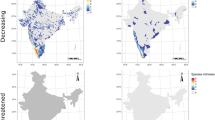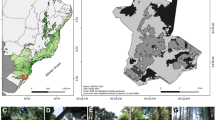Abstract
In this paper, we report the results of an experimental study on ant pollination of three plant species inhabiting the Mediterranean high mountains (Alyssum purpureum, Arenaria tetraquetra and Sedum anglicum) and four species inhabiting the aridlands (Lepidium subulatum, Gypsophyla struthium, Frankenia thymifolia and Retama sphaerocarpa) of South-eastern Spain. We determined several plant and ant traits, as well as the composition and abundance of the pollinator assemblage. Insects belonging to 29 families and five orders visited the flowers of the plant species studied. In all but two, L. subulatum and G. struthium, the ants comprised 70–100% of the flower visitors. The results clearly show that five out of seven of these plant species were pollinated by ants. The role of the ants as pollinators seems to depend heavily on the relative abundance of the ants with respect to the other species of the pollinator assemblage, ant pollination becoming evident when ants outnumber other floral visitors. The ant-pollination systems analysed in this study may be the result of prevailing ecological conditions more than an evolutionary result of a specialized interaction.
Similar content being viewed by others
References
Beattie AJ (1991) Problems outstanding in ant-plant interaction research. In: Huxley CR, Cutler DF (eds) Ant-plant interactions. Oxford University Press, Oxford, pp 559–576
Beattie AJ, Turnbull C, Knox RB, Williams EG (1984) Ant inhibition of pollen function: a possible reason why ant pollination is rare. Am J Bot 71: 421–426
Beattie AJ, Turnbull C, Hough T, Jobson S, Knox RB (1985) The vulnerability of pollen and fungal spores to ant secretions: evidence and some evolutionary implications. Am J Bot 72: 606–614
Charlesworth D (1989) Evolution of low fertility in plants: pollen limitation, resource allocation and genetic load. Trends Ecol Evol 4: 289–292
Fernández Escudero I (1994) Estudio de la biología de Proformica longiseta Collingwood, 1978 (Hymenoptera, Formicidae). Phd dissertation, Universidad de Granada, Granada, Spain
Fritz RS, Morse DH (1981) Nectar parasitism of Asclepia syriaca by ants: effect on nectar levels, pollinia removal and pod production. Oecologia 50: 316–319
Galen C (1983) The effects of nectar-thieving ants on seed set in floral scent morphs of Polemonium viscosum. Oikos 41: 245–249
Gómez JM (1994) Importance of direct and indirect effects in the interaction between a parasitic angiosperm (Cuscuta epithymum) and its host plant (Hormathophylla spinosa). Oikos 71: 97–106
Gómez JM, Zamora R (1992) Pollination by ants: consequences of the quantitative effects on a mutualistic system. Oecologia 91: 410–418
Harder LD, Thomson JD (1989) Evolutionary options for maximizing pollen dispersal of animal-pollinated plants. Am Nat 133: 232–244
Herrera CM, Herrera J, Espadaler X (1984) Nectar thievery by ants from southern Spanish insect-pollinated flowers. Insectes Soc 31: 142–154
Hickman JC (1974) Pollination by ants: a low energy system. Science 184: 1290–1292
Hódar JA (1993) Relaciones tróficas entre los passeriformes insectívoros en dos zonas semiáridas del sureste peninsular. Phd dissertation, Universidad de Granada, Granada, Spain
Hölldobler B, Engel-Siegel H (1984) On the metapleural gland of ants. Psyche 91: 201–224
Holsinger KE, Thomson JD (1994) Pollen discounting in Erythronium grandiflorum: mass-action estimates from pollen transfer dynamics. Am Nat 144: 799–812
Hull DA, Beattie AJ (1988) Adverse effect on pollen exposed to Atta texana and other North American ants: implications for ant pollination. Oecologia 75: 153–155
Pant DD, Nautiyal DD, Chaturverdi SD (1982) Pollination ecology of some Indian asclepiads. Phytomorphology 32: 302–313
Peakall R (1989) The unique pollination of Leporella fimbriata (Orchidiaceae): pollination by pseudocopulating male ants (Myrmecia urens, Formicidae). Plant Syst Evol 167: 137–148
Peakall R, Beattie AJ (1989) Pollination of orchid Microtis parviflora R.Br. by flightless worker ants. Funct Ecol 3: 515–522
Peakall R, Beattie AJ (1991) The genetic consequences of worker ant pollination in a self-compatible, clonal orchid. Evolution 45: 1837–1848
Peakall R, Beattie AJ, James SH (1987) Pseudocopulation of an orchid by male ants: a test of two hypotheses accounting for the rarity of ant pollination. Oecologia 73: 552–554
Peakall R, Angus CJ, Beattie AJ (1990) The significance of ant and plant traits for ant pollination in Leporella fimbriata. Oecologia 84: 457–460
Peakall R, Handel SN, Beattie AJ (1991) The evidence for and importance of, ant pollination. In: Huxley CR, Cutler DF (eds) Ant-plant interactions. Oxford University Press, Oxford, pp 421–428
Petersen B (1977a) Pollination by ants in the alpine tundra of Colorado. Trans Ill State Acad Sci 70: 349–355
Petersen B (1977b) Pollination of Thlaspi alpestre by selfing and by insects in the alpine zone of Colorado. Arctic Alp Res 9: 211–215
Retana J, Bosch J, Alsina A, Cerdá X (1987) Foraging ecology of the nectarivorous ant Camponotus foreli (Hymenoptera, Formicidae) in a savanna-like grassland. Misc Zool 11: 187–193
Rico-Gray V (1989) The importance of floral and circum-floral nectar to ants inhabiting dry tropical lowlands. Biol J Linn Soc 38: 173–181
Sanderson T, Wright PJ (1989) Inhibition of pollen germination by ant secretions. Act Coll Insectes Soc 5: 25–30
Sánchez Piñero F (1994) Ecología de las comunidades de coleópteros en zonas áridas de la depresión de Guadix-Baza (sureste de la Península Ibérica). Phd dissertation, Universidad de Granada, Granada, Spain
Thomson JD, Thomson BA (1989) Dispersal of Erythronium grandiflorum pollen by bumblebees: implications for the gene flow and reproductive success. Evolution 43: 657–661
Unwin DM, Corbet SA (1991) Insects, plants and microclimate. Naturalists' Handbooks 15, Richmond, Slough
Wyatt R (1980) The impact of nectar-robbing ants on the pollination system of Asclepias syriaca. Bull Torrey Bot Club 107: 24–28
Wyatt R (1981) Ant-pollination of the granite outerop endemic Diamorpha smallii (Crassulaceae). Am J Bot 68: 1212–1217
Wyatt R, Stoneburner A (1981) Patterns of ant-mediated pollen dispersal in Diamorpha smallii (Crassulaceae). Syst Bot 6: 1–7
Zamora R (1987) Dinámica temporal y selección de hábitat de los Passeriformes de la alta montaña de Sierra Nevada. Phd dissertation, Universidad de Granada, Granada, Spain
Zar JH (1984) Biostatistical analysis, 2nd edn. Prentice Hall, Englewood Cliffs, NJ
Author information
Authors and Affiliations
Corresponding author
Rights and permissions
About this article
Cite this article
Gómez, J.M., Zamora, R., Hódar, J.A. et al. Experimental study of pollination by ants in Mediterranean high mountain and arid habitats. Oecologia 105, 236–242 (1996). https://doi.org/10.1007/BF00328552
Received:
Accepted:
Issue Date:
DOI: https://doi.org/10.1007/BF00328552




